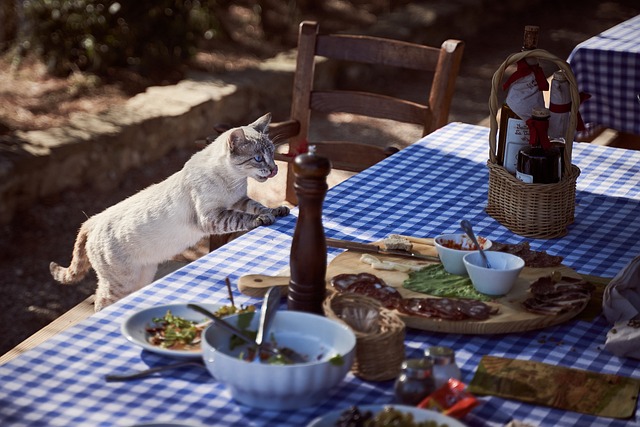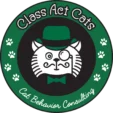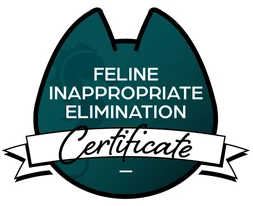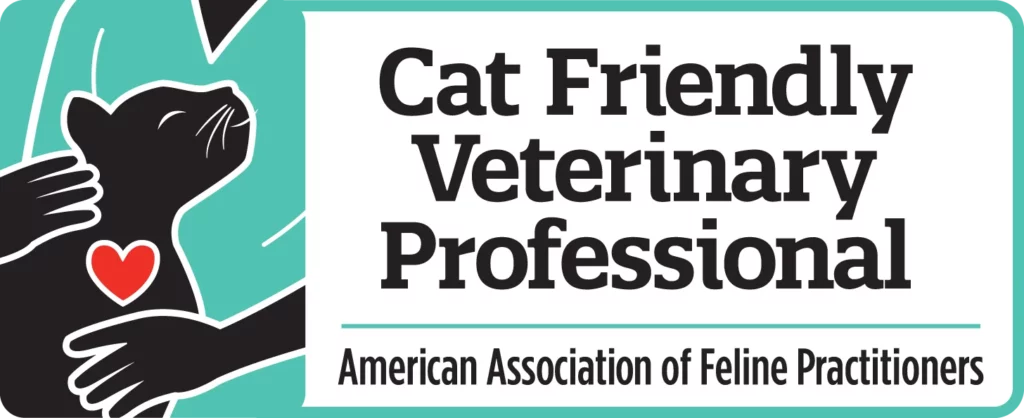If your cat isn’t eating, it can be very frustrating to get them to eat. Getting a cat to eat can be complex as feeding and food related behaviors in cats aren’t always intuitive to us. Toward the end of his life, my cat Zoloft began eating less and was pickier about what he was eating so unfortunately, I have a lot of personal experience with this topic.
While this guide is on feeding behaviors in cats, I won’t be going into the nutrition side of things. My focus is on the behavior, not necessarily what the cat is eating. I also am focusing on cats that don’t have a strict diet due to allergies or other medical conditions. I suggest running any concerns you may have or getting advice on what to feed your cat from your veterinarian.
Start With A Veterinarian Appointment
Before we go any further, I want to start with the most important piece of advice: get your cat in to see the vet. If you notice any changes in your cat’s appetite, especially if it isn’t improving, they need to be examined by a veterinarian to rule out medical causes of appetite loss. If you let the underlying problem go on too long, you may end up with a more serious problem or may put a lot of effort into getting your cat to eat when there may be an easier solution.
If your veterinarian suggests something that goes against what I suggest, please listen to them. They are examining your cat individually and my advice is for cats in general. They may also have a specific reason for recommending something. For example, they may recommend a type of diet to give your cat’s tummy a chance to settle a bit. If they say nothing a GI-specific food and I suggest adding baby food to the mix, your vet’s advice goes before mine. Try some of the other strategies!
How Cats Decide What To Eat
Let’s very briefly look at how cats decide what to eat and how they eat in nature. Cats are obligate carnivores, meaning they need to have meat in their diets or they could be at risk for serious health consequences. They naturally seek out foods that are on the savory flavor spectrum and are high in protein. A recent study found that the savory quality known as umami is likely why cats love the flavor of tuna.

Of course, tuna isn’t the only food with an umami taste to it. Cats develop preferences for specific flavors based on what they eat as kittens, though their preferences may change somewhat during their lifetime. Cats tend to like very stinky things as they have a stronger sense of smell than taste. Cats will also show a preference for certain textures of foods over others. They may prefer a pate style food or one that is more chunky with gravy, but they’ll be unlikely to deviate from what textures they prefer.
In nature, cats eat what they hunt. Generally, they’re going to hunt and eat small creatures like birds or mice (hence why many cat toys are similar in size and shape to these creatures) multiple times per day and hunt solo. Cats also will eat their kill right away so they can replenish their energy stores for their next hunt.
Strategies For Getting A Cat To Eat
How do we apply cats’ natural behaviors around food in a practical way to get your cat eating? Some of the easiest methods involve what you’re feeding your cat. Even if your cat ate it, they may not have loved the food so starting with the most basic component of their meal is a starting place.
Try A Different Flavor
Cats have individual preferences for flavors that tend to be consistent across time. Our Chief Purr Officer Zoloft loved chicken and turkey flavored foods throughout his entire time with me. Offer him something salmon flavored, however, and he’d act offended. Our new Chief Whisker Officer and Chief Catnip Officer both like most flavors so far so they’re less picky, but there does seem to be a preference for chicken flavors with both of them as well. They will, however, eat up a tasty salmon Churu without complaint.
If your cat doesn’t seem to be liking the flavor you’re offering, try one they may like a bit more. Go based on what they’ve eaten in the past if you can, though you may need to purchase a few different flavors to experiment with what your cat will like. If your cat is new, consider trying something similar to what they were being fed before.
Offer A Different Texture
Cats will prefer certain textures of food with some preferring foods with more chunks, some preferring crunchy foods, and some may like foods that have more gravy. Getting a cat to eat a texture they hate would be like getting me to eat mushrooms (which I hate due to their texture). Consider trying a food with a different texture your cat may like more. That means trying both dry and wet styles of food.
Looking for a crunchy treat that’s a bit healthier? Consider freeze-dried minnows. Cats seem to like the crunch of them and they’re easy to offer as a quick treat when your kitty is feeling better, too!
Mix In Something Tasty (And Stinky)
Don’t hesitate to use treats to your advantage. When Zoloft was sick toward the end of his life, I’d often mix turkey or chicken baby food with his regular food. He’d gobble it right up as baby food is essentially super concentrated pureed meat. You can also try the magic of Churu, which comes in about a bajillion flavors, to see if that will entice your cat.

You can buy food toppers designed to be mixed into food and enhance their flavor. Some cats like the taste of FortiFlora, a probiotic that can be mixed into wet food. It apparently has a nice savory taste to it that cats like and will get some cats to gobble down their food.
Mix Wet And Dry Food
If you are concerned about your cat not eating enough wet food, but they prefer dry food, you can consider doing a mixture of both. The kibble will absorb some of the liquid in the wet food so you may have to experiment with the right proportion of wet to dry so your cat will still eat it, but this may entice them to eat a little bit of each. You can also try topping the dry food with just a bit of wet food if your cat really isn’t going for it.
Feeding Methods For Getting A Cat To Eat
Not all strategies for getting a cat to eat involve the type of food you’re offering them. Some may involve how you’re offering the food so you can try a few of these options without needing to completely alter the type of food your cat gets.
Change The Temperature
Cats are usually going to eat a fresh kill in nature so it will still be warm. Warming up wet food will make it more appealing to your cat. Plus, the increase in temperature will make the molecules of the food move around faster and make the scent stronger. This will help increase the appeal, too! Nuke their food for a couple seconds in the microwave, making sure to not serve it too hot.
While cats generally will prefer warmed-up food, some may prefer room temperature or even chilled food. Try them all and see what your cat likes best.
Try A Different Food Dish
Some cats may have a preference for a particular type of food dish. For example, Persian cats have flat faces and will have a hard time eating out of bowls that are too deep. Get them a flat bowl instead. Flat bowls may appeal to other cats as well as it’s easier on their whiskers. Similarly, cats who are older may prefer a raised bowl so it’s easier on their neck. You can also try setting a regular bowl on a small box just to test if you can get your cat to eat out of it before committing to a raised bowl.
In some cases, it may even be the material the bowl is made of that is the problem. While it’s best to avoid plastic bowls, either stainless steel or ceramic bowls are an option. Consider trying a different material or even just using a plate to see what your cat likes best.
A Word On Food Puzzles
I make it no secret that I love puzzle feeders as a way to feed cats. If your cat isn’t eating, you may want to hold off on trying them right away. They could be the solution if your cat prefers a mealtime challenge, but if your kitty isn’t feeling their best you don’t want to make eating more of a challenge.
Offer Smaller Meals
Cats hunt small things in nature so they’re not used to eating 1 or 2 larger meals per day like how we may feed them. They’d actually prefer a few smaller meals spread throughout the day (which can help prevent cats from turning into chonks and keep them full during the day so they don’t get as antsy around meal time). Try offering a small amount of food to your cat and then offer a similar amount at a few other intervals during the day to see if that entices them to eat a bit more.
While this may work for getting your cat to eat, it may not be super practical with your schedule. An automatic feeder is a great way to take some of the work out of this. And yes, there are automatic feeders that are compatible with wet food that will keep it cool during the day.
Feed Them Alone
While humans are social eaters who like eating in groups, cats feel very differently. Cats typically don’t like eating in groups (hence why I don’t recommend feeding your cats near each other when introducing new cats) as they’re naturally solitary hunters. They might put up with eating near another cat when their mood is fine, but if they aren’t feeling well then cats aren’t going to want to add more stress to their lives.
If you usually feed your cats near each other, try moving their meals to separate locations to see if you can get the non-eating cat to eat. Actually, you honestly should be doing this anyway so maybe just start feeding your cats separately now. If you have one cat constantly going after another cat’s food, make your life easy and get a microchip-activated feeder. Only the cat you want will be able to get the food.
What If My Cat Still Won’t Eat?
If you’ve tried all of the above strategies and your cat still isn’t eating, a return visit to the vet may be a good idea as there may be more to investigate. If they still can’t find anything, you can try repeating some of the strategies in a different way. For example, try a different flavor you haven’t tried yet or try a flavor your cat seemed to at least like via a different feeding method.
If you’re really stumped, it may be time to call in the professionals. Feel free to set up a consultation and we’ll go over what we can do to get your kitty to happily lick up their whole dinner!










